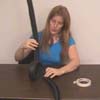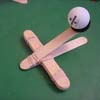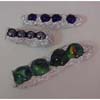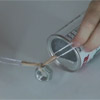
Science Teleclass Bonus Experiments
 Enroll in e-Science NOW!
Enroll in e-Science NOW!
If you want your kids to learn Science in a way that really lasts long-term, by doing activities that are genuinely educational and also fun... then e-Science is for you. Click here to enroll now.
 Roller Coasters
Roller Coasters
Roller coasters are a prime example of energy transfer from potential to kinetic and back. We're going to build monster roller coasters in your house using just a couple of simple materials.
 Catapults
Catapults
The higher you pitch a ball upwards, the more energy you store in it. Instead of breaking our arms trying to toss balls into the air, let's make a simple machine that will do it for us.
 Bobsleds
Bobsleds
Bobsleds use the low-friction surface of ice to coast downhill at ridiculous speeds. You start at the top of a high hill (with loads of potential energy) then slide down a icy hill until you transform all that potential energy into kinetic energy.
 Mystery Toy
Mystery Toy
You can easily create one of these mystery toys out of an old baking powder can, a heavy rock, two paper clips, and a rubber band. It will keep small kids and cats busy for hours!
 Abridged Science Lesson Plan
Abridged Science Lesson Plan
This sample of the manual included with the Science Mastery Program contains Unit 5: Energy . Note: Adobe Acrobat is required for downloading the manual. (If you have problems downloading the manual you may need to reinstall Acrobat first.)
Roller Coasters
Materials:
- marbles
- masking tape
- 3/4" pipe foam insulation (NOT neoprene and NOT the kind with built-in adhesive tape)
Roller coasters are a prime example of energy transfer: You start at the top of a big hill at low speeds (high gravitational potential energy), then race down a slope at break-neck speed (potential transforming into kinetic) until you bottom out and enter a loop (highest kinetic energy, lowest potential energy). At the top of the loop, your speed slows (increasing your potential energy), but then you speed up again and you zoom near the bottom exit of the loop (increasing your kinetic energy), and you're off again!
This lab is an excellent opportunity for kids to practice their resilience, because we guarantee this experiment will not work the first several times they try it. While you can certainly help the kids out, it's important that you help them figure it out on their own. You can do this by asking questions instead of rushing in to solve their problems. For instance, when the marble flies off the track, you can step back and say:
“Hmmm… did the marble go to fast or too slow?”
“Where did it fly off?”
“Wow – I'll bet you didn't expect that to happen. Now what are you going to try?”
Become their biggest fan by cheering them on, encouraging them to make mistakes, and try something new (even if they aren't sure if it will work out).
Catapults
Materials:
- 9 tongue-depressor size popsicle sticks
- four rubber bands
- one plastic spoon
- ping pong ball or wadded up ball of aluminum foil (or something lightweight to toss, like a marshmallow)
- hot glue gun with glue sticks
We're utilizing the “springy-ness” in the popsicle stick to fling the ball around the room. By moving the fulcrum as far from the ball launch pad as possible (on the catapult), you get a greater distance to press down and release the projectile. (The fulcrum is the spot where a lever moves one way or the other – for example, the horizontal bar on which a seesaw “sees” and “saws”.)
Bobsleds
Materials:
- aluminum foil
- marbles (at least four the same size)
- long tube (gift wrapping tube or the clear protective tube that covers fluorescent lighting is great)
While you can make a tube out of gift wrap tubes, it's much more fun to use clear plastic tubes (such as the ones that protect the long overhead fluorescent lights). Find the longest ones you can at your local hardware store. In a pinch, you can slit the gift wrap tubes in half lengthwise and tape either the lengths together for a longer run or side-by-side for multiple tracks for races. (Poke a skewer through the rolls horizontally to make a quick-release gate.)
If you're finding that the marbles fall out before the bobsled reaches the bottom of the slide, you need to either crimp the foil more closely around the marbles or decrease your hill height.
Check to be sure the marbles are free to turn in their “slots” before launching into the tube – if you've crimped them in too tightly, they won't move at all. If you oil the bearings with a little olive oil or machine oil, your tube will also get covered with oil and later become sticky and grimy… but they sure go faster those first few times!
Mystery Toy
Materials:
- can with a lid
- heavy rock or large nut
- two paper clips
- rubber band
Now for the fun part... gently roll the can on a smooth floor away from you. The can should roll, slow down, stop, and return to you! If it doesn't, check the rubber band tightness inside the can.
The hexnut is a weight that twists up the rubber band as the can rolls around it. The kinetic energy (the rolling motion of the can) transforms into potential (elastic) energy stored in the rubber band the free side twists around. The can stops (this is the point of highest potential energy) and returns to you (potential energy is being transformed into kinetic). The farther the toy is rolled the more elastic potential energy it stores.
Learn more about catapults, roller coasters, lasers, robotics, and so much more!
You're going to find out exactly how to make these and hundreds more projects in the Study Units of the e-Science program.
YES!!! Get Me Started With e-Science Now. I'm Ready To Join e-Science And Have My Kids Learn Science While Having Fun!
Click Here To Enroll Now!
(NOTE: The annual enrollment offer is only available TODAY!)
If you want your kids to learn Science in a way that really lasts long-term, by doing activities that are genuinely educational and also fun... Then e-Science is for you.
e-Science includes hundreds of hands-on Science experiments and activities (taught step-by-step through detailed videos). You'll instantly have access to over 100 experiments and activities. Then, every month you'll get access to another set of lessons with another 60 to 80 new experiments. There are over 800 activities and experiments total in e-Science.
You'll also get practical real-world explanations, personal support for questions, 24/7 access so you can do it on your own schedule, and a format that kids really find fun.
Best of all, e-Science is taught in a way that lets kids go through it on their own, so you only need to accompany them if you want to.
Here's What You'll Get When You Enroll In e-Science Today...
- All the extra bonuses I described in the online class
- Access to hundreds of Science activities, experiments and projects, with dozens of new ones coming each month until you have access to all 800+ of them!
- A place to ask questions and get answers.
- Live Q & A Calls with me (Aurora) personally.
- Detailed videos explaining each new topic, with written explanations and summaries .
- A simple, easy-to-use structure that kids can go through on their own.
- A Special Science Parts & Pieces shipped right to your door! (USA addresses only)
- All kids in your household can enroll in e-Science for the price of one!
Today, you can enroll and get the bonuses for 70% off their regular price. Right now you can enroll in e-Science for a full year for just $333 (or 6 monthly payments of $59) for the grade K-8 curriculum. For more advanced kids, the advanced grade 5-8 & High School level program is only $513 for a full year (or 6 monthly payments of $87).